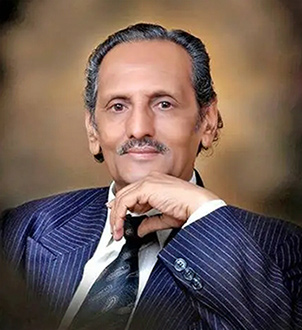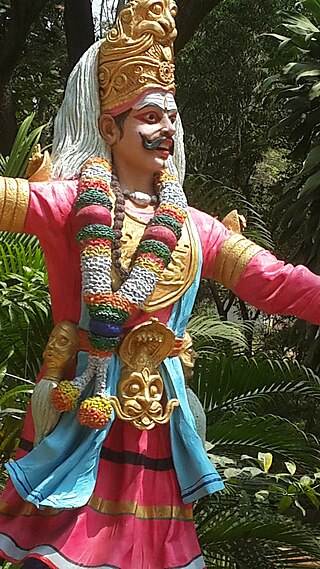
Yakshagana is a traditional theatre, developed in Dakshina Kannada, Udupi, Uttara Kannada, Shimoga and western parts of Chikmagalur districts, in the state of Karnataka and in Kasaragod district in Kerala that combines dance, music, dialogue, costume, make-up, and stage techniques with a unique style and form. It is believed to have evolved from pre-classical music and theatre during the period of the Bhakti movement. It is sometimes simply called "Aata" or āṭa. This theatre style is mainly found in coastal regions of Karnataka in various forms. Towards the south from Dakshina Kannada to Kasaragod of Tulu Nadu region, the form of Yakshagana is called Thenku thittu and towards the north from Udupi up to Uttara Kannada it is called Badaga thittu. Both of these forms are equally played all over the region. Yakshagana is traditionally presented from dusk to dawn. Its stories are drawn from Ramayana, Mahabharata, Bhagavata and other epics from both Hindu and Jain and other ancient Indic traditions.
Arebhashe or Aregannada or Gowda Kannada is a dialect of Kannada mainly by Gowda communities in the region Madikeri, Somwarpet, and Kushalnagar taluks of Kodagu district, Sullia, taluks of Dakshina Kannada district; Bangalore and Mysore districts in the Indian state of Karnataka. As well as Bandadka, Kasaragod District in the Indian state of Kerala, Arebhashe is also called Gowda Kannada. The language was recognized by the Karnataka State government and formed an academy in 2011 to preserve the culture and literature of the Arebhahse Region which is named as Karnataka Arebhashe Samskruthi mathu Sahitya Academy supported by then Chief Minister D. V. Sadananda Gowda.

Manipuri dance, also referred to as the Manipuri Raas Leela, is a jagoi and is one of the major Indian classical dance forms, originating from the state of Manipur. It is one of the greatest cultural achievements of the traditional Vaishnavism adhering Meitei people of Manipur. Owing to the Meitei civilization, the classical dance form, first formally developed by Meitei Hindu king Ching Thang Khomba of the Kingdom of Manipur, is considered to be the highest spiritual expression of the worship of Hindu deity Krishna. Owing to its huge influences on the diverse cultural heritages across the Indian subcontinent, it is recognised by the Sangeet Natak Akademi of the Ministry of Culture of the Government of India as one of the few primary classical dance forms of the Republic of India, and is honoured with the Sangeet Natak Akademi Award for Manipuri annually. It is referred to as the "national dance" during the Armenia-India joint issue of postage stamps, as a part of the Armenia-India international relations.

Male Mahadeshwara Betta is a pilgrim town located in the Hanur taluk of Chamarajanagar district of southern Karnataka. It is situated at about 150 km from Mysuru and about 210 km from Bengaluru. The ancient and sacred temple of Sri Male Mahadeshwara is a pilgrim centre where Mahadeshwara lived, practiced medicine as Sidda, taught ahimsa to people in and around the seven hills. It draws lakhs of pilgrims from the states of Karnataka and Tamil Nadu. The area of the present temple surroundings is 155.57 acres (0.6296 km2). In addition, the temple has lands at Talabetta, Haleyuru and Indiganatha villages. Amidst dense forest, the temple attracts not only the pilgrims but also nature lovers. The height of the hill is about 3000 feet above sea level.
Thiriyuzhichil is a dance ritual performed by Pulluvas in Kerala to alleviate the fear of snakes, to appease the snake and to be blessed with babies. This is more popular in the districts of Trichur, Calicut and Palghat and it is performed in Hindu Temples and shrines meant for snakes. By performing this, the queen of snakes could be appeased. The performer starts dancing holding a torch in his hand using various types of music instruments.
The dance forms of Andhra Pradesh take on a wide variety of colors, costumes, and types; and involve different settings and musical instruments.

Būta Kōlā, also referred to as Daiva Kōlā or Daiva Nēmā, is a shamanistic dance performance prevalent among the Hindus of Tulu Nadu and parts of Malenadu of Karnataka and Kasargod in northern Kerala, India. The dance is highly stylized and performed as part of 'Bhootaradhane' or worship of the local deities worshipped by the Tulu speaking population. It has influenced Yakshagana folk theatre. Būta kōlā is closely related to Theyyam of North Malabar region.

Nagaradhane is a form of serpent worship which, along with Bhuta Kola, is one of the unique traditions prevalent in coastal districts of Dakshina Kannada, Udupi and Kasaragod collectively known as Tulu Nadu, practiced by Tuluva community members. Cobras are not just seen as deities, but as an animal species which should be respected, appeased and protected for multiple social, religious and ecological reasons.

Kokkare Hosahalli Shekh Haider Nissar Ahmed was an Indian poet and writer in the Kannada language. He was awarded the Padma Shri (2008), the Rajyotsava Award (1981) and the Pampa award for his work (2017). He became a household name for his work Nityotsava, which is a poem about Karnataka, a piece he composed after seeing Jog falls. He has numerous poems, translations and children's books to his credit. He is known for using simple words that resonate deeply with the public in his literary work.
Banakal is a Malnad town in Mudigere Taluk, Chikkamagaluru district of Karnataka, India. This town is situated atop the Charmadi hills in the Western Ghats section. The Western Ghats is one amongst twenty-five identified hot spots for biodiversity conservation in the world. Banakal is surrounded by coffee estates and paddy fields and known for its pleasant weather throughout the year. Banakal town is the headquarters of Banakal Hobli.

Karnataka has a variety of traditional arts, including folk dance and puppetry.

Gaarudi Gombe is a folk dance prevalent in the state of Karnataka, India. Dancers adorn themselves with giant doll-suits made of bamboo sticks. The term Gaarudi-Gombe means magical-doll in the native language, Kannada. This dance is performed during major festivals and also in the procession held during the festivities of Mysore Dasara. This dance is also known as Tattiraya in the coastal districts of Karnataka. The term Tattiraya means a person carrying a doll made of bamboo sticks.

Chandrashekhara Basavanneppa Kambara is a prominent Indian poet, playwright, folklorist, film director in Kannada language and the founder-vice-chancellor of Kannada University in Hampi also president of the Sahitya Akademi, country's premier literary institution, after Vinayak Krishna Gokak (1983) and U.R. Ananthamurthy (1993). He is known for effective adaptation of the North Karnataka dialect of the Kannada language in his plays, and poems, in a similar style as in the works of D.R. Bendre.
Tulu Gowda and Arebhashe Gowda (Gauda) are primarily found in South Canara District, Kodagu District, Indian state of Karnataka and Bandadka village of Kasaragod. They are officially considered a subsect of the Vokkaliga community but are culturally and linguistically different. They speak Tulu and Arebhashe.

History of clothing in the Indian subcontinent can be traced to the Indus Valley civilization or earlier. Indians have mainly worn clothing made up of locally grown cotton. India was one of the first places where cotton was cultivated and used even as early as 2500 BCE during the Harappan era. The remnants of the ancient Indian clothing can be found in the figurines discovered from the sites near the Indus Valley civilisation, the rock-cut sculptures, the cave paintings, and human art forms found in temples and monuments. These scriptures view the figures of human wearing clothes which can be wrapped around the body. Taking the instances of the sari to that of turban and the dhoti, the traditional Indian wears were mostly tied around the body in various ways.

Janapada Loka, is a folk museum that has an exclusive display of the village folk arts of Karnataka. It is under the aegis of the Karnataka Janapada Parishat. Loka Mahal, a wing in the museum has a display of 5,000 folk artifacts. It is situated in Ramanagara, Ramanagara district in the Indian state of Karnataka, on the Bangalore-Mysore highway, 53 kilometres (33 mi) to the south of Bangalore.
Annamma Betta is a Christian pilgrim centre in the city of Bengaluru (Bangalore), Karnataka, and is situated in the Uttarahalli and Arehalli hill ranges. This hillock is also referred to as Hanumagiri Betta or Annamma Betta or Yesu Betta or even Shilube Betta. Days are these where the trees are uprooted and the lush greenery is blackened, and same is the fate of small hillocks in and around Bengaluru.

Kangeelu or Kangilu is a traditional folk dance from Udupi and Dakshina Kannada region in the South Indian state of Karnataka. It is a spiritual dance performed on the full moon day in Mai month of Tulu calendar. It is believed to keep away disease, evil spirits, and other negative energy and serves to foster peace, harmony, and a community spirit. The dance is performed as a part of a seven day Kangilu Kunitha to propitiate the goddess Khadgeshwari and Koragajja, a spirit considered as a form of god Shiva.
Pratibha Nandakumar is an Indian poet, journalist, feminist, columnist and activist who works in Kannada and English. She is considered as one of the pioneers of modern woman's poetry in Kannada literature. For her work Kavadeyaata, Pratibha was awarded the Karnataka Sahitya Akademi Award for Poetry in 1998.
Sakhiya dance is a Nepalese traditional dance performed by the Tharu community during the Dashain and Tihar festivals. Officially, it begins on the day of Krishna Janmashtami. The dance is mainly performed by the unmarried young girls and boys. In the first phase, boys play drums and girls use pumpkin leaves. In the second phase, girls use jute fabric and in the final phase, girls have to use cymbals which is known as Majaira in Tharu language. Boys wear Dhoti and Jhuluwa while girls wear Choliya and Fariya. Various ornaments and jewelries are also worn.











